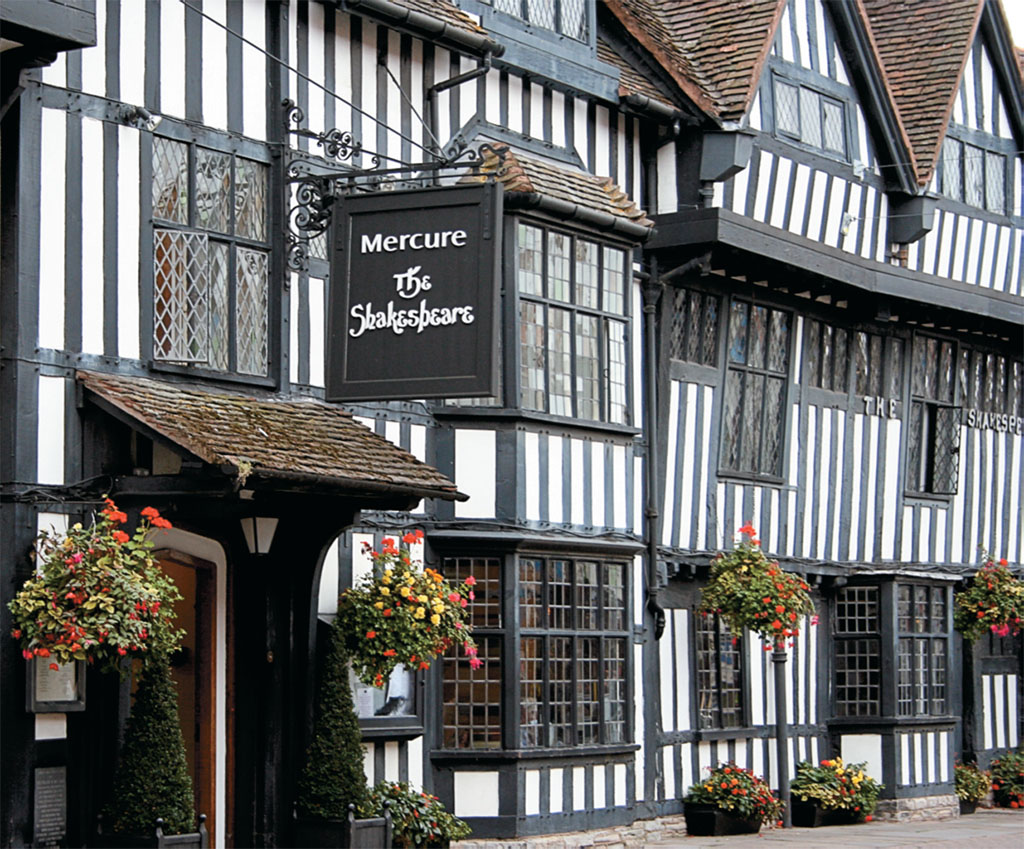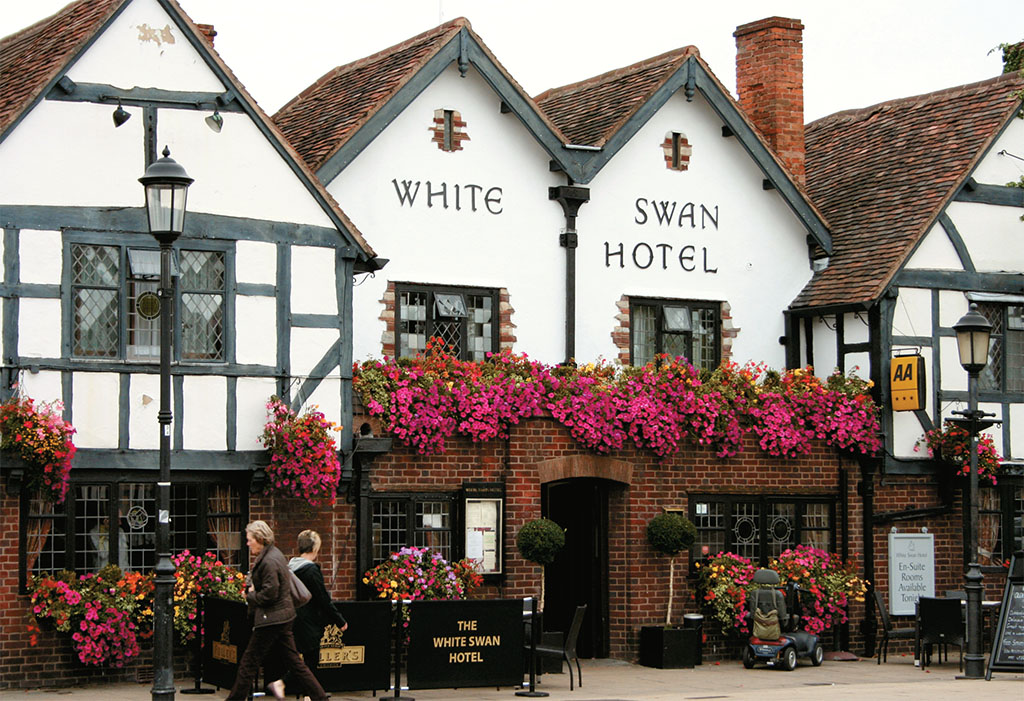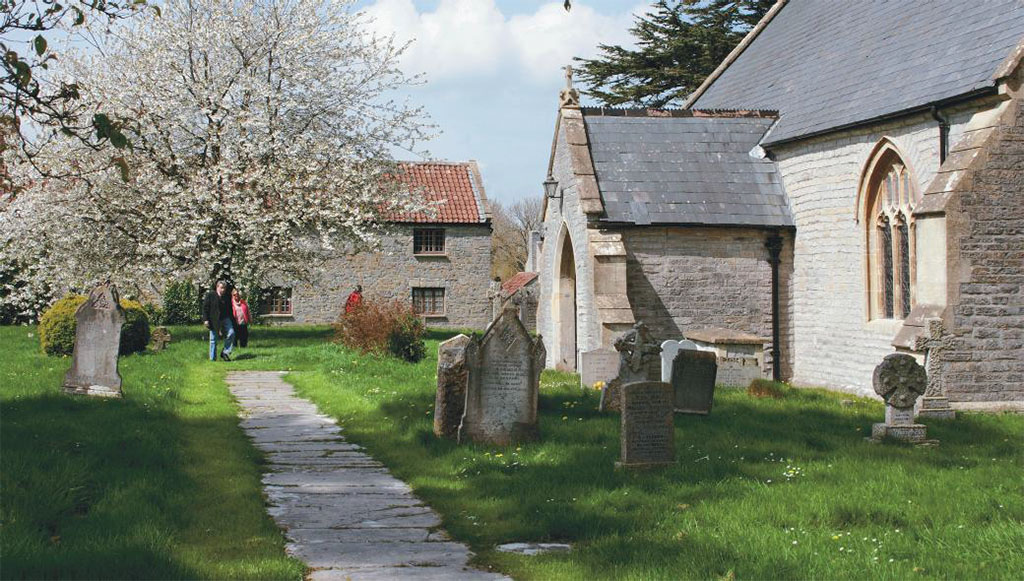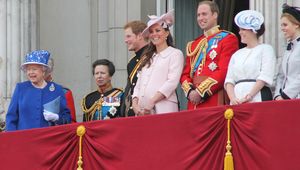
It gets all those visitors for good reason
[caption id="Stratford_img1" align="aligncenter" width="1024"]

Dana Huntley
When my parents made their first trip to England, they took a tour on a really big bus that stopped at all the standard destinations. They loved every bit of it, with a naive innocence that the British might call “gormless,” and Stratford-upon-Avon was their particular favorite. “Such a wonderful English village!” they exclaimed. Many years later they returned as experienced, independent travelers. “We were so disappointed. It’s nothing like we remembered,” they reported. “It’s just a big, noisy tourist town.”
Stratford-upon-Avon is indeed a tourist town, and has been for 150 years. It’s quite handsome and low key as tourist towns go, but an experienced traveler will find it a pastiche of a true market town, and nothing at all like a village. Still, it’s worth a visit, and you don’t have to be gormless to enjoy it; you just need the right approach.
Just a Tudor market town
Of course, Stratford was once a real market town, noted for its sheep and wool. In the 16th century the Shakespeare family numbered among its worthies, having made their fortune by siding with Henry Tudor at the Battle of Bosworth Field, then defying the rest of the Tudors by selling black-market wool. In their day Stratford was a small place, tightly jammed into a two by four block grid, which remains its historic center. Every Thursday several animal markets—a very large wool and mutton market, a cattle market and a pig market—would crowd the streets house to house, reeking of fresh dung and fresh blood.
While the aristocracy cleverly chose to live outside town on their country estates, the town’s burgesses (such as the Shakespeares) built themselves urban mini-manors at its center. These were both assertions of their prosperity and places to run their businesses—office, warehouse, workshop and home. Architecturally they were conservative, about 50 years out of date compared to what nobles were building for the same amount of money. In Shakespeare’s time this meant good, solid post-and-beam construction, none of your fancy-pants Renaissance nonsense. Structurally, the weight of the floors and roof was born on rectangles made of squared timbers, with the space within filled by wattle and daub. There would be no attempt to plaster over the timbers themselves; quite the contrary, a burgess wanted to show off how much expensive wood he could afford, and would frequently stick in extra timbers. These give Stratford its characteristic look, preserved in a few old buildings and copied in many modern ones.
[caption id="Stratford_img2" align="aligncenter" width="1024"]

Dana Huntley
[caption id="Stratford_img3" align="aligncenter" width="1024"]

Dana Huntley
[caption id="Stratford_img4" align="aligncenter" width="1024"]

Dana Huntley
[caption id="Stratford_img5" align="aligncenter" width="1024"]

Dana Huntley
In short, Stratford was a typical rural town, unusual only in producing William Shakespeare. William’s dad, John, seems to have run a glover business (a low status, low paying job) as a front for wool smuggling and usury. Starting in business in 1552 at age 22, he was able to purchase his own large town house on Henley Street after just four years. This served as the family home for almost 50 years, during which John would marry into Catholic gentry, hold a series of important town offices and sire eight children. William, the third child and eldest son, was born there in 1564. Married in 1583, William was spending time in London’s theaters by 1592, with so much success that, in 1596, he purchased one of Stratford’s most expensive and impressive houses, just three blocks from his parents. William and his family would live there until the Bard’s death in 1616.
Although Stratford’s tourism emerged slowly, it was already well established when Shakespeare’s parents’ home came on the market in 1846. P.T. Barnum threatened to purchase it and ship it to America “brick by brick,” and this kicked up such a rumpus that a committee, the Shakespeare Birthplace Trust, was formed to purchase and restore it. They did, in one of the earliest expressions of the historic restoration movement now so important. Stratford had entered its modern phase.
Stratford itself is a show
For the experienced Stratford tourist, visiting the properties of the Shakespeare Birthplace Trust plays second only to sitting in one of the plentiful sidewalk cafes and watching other tourists. The Trust has eight historic properties split between town and countryside. Foremost of these properties is Shakespeare’s Birthplace in the town’s old center, restored to its original appearance, with period furnishings, interpretive exhibits and a fine garden. The Trust also has the site of Shakespeare’s adult home (it burned down in 1759), his wife’s house, his grandparents’ house, his grandparents’ farm, a farmhouse once thought to belong to his grandparents but didn’t, his daughter’s house, his grandson-in-law’s house and the house of the mother of John Harvard, the founder of Harvard University. There are other historic buildings in Stratford, as well as skilled Victorian homages and clumsy modern imitations (look for black one-by-fours nailed onto white plaster), but the Trust sites should keep you busy.
[caption id="Stratford_img6" align="aligncenter" width="807"]

Dana Huntley
[caption id="Stratford_img7" align="aligncenter" width="1024"]

Dana Huntley
Next up is the riverside. Actually, this comes first, as it’s where you will park; a large public park on the east bank of the Avon has an immense number of pay and display spaces, and you won’t be able to get any closer or any cheaper. Stroll through the park, along the riverside, and over the Avon on a pedestrian bridge to the canal boat basin. There are places to have tea and feed the ducks, places to rent punts and rowboats, a chain ferry and an early industrial tram, and old riverside buildings converted into places to spend money.
[caption id="Stratford_img8" align="aligncenter" width="1024"]

NORWICH HERITAGE ECONOMIC & REGENERATION TRUST
After the Trust and the riverside, schedule a night at the Royal Shakespeare Company. While the RSC likes to claim an ancient lineage going back to David Garrick in the 1760s, it actually dates to 1959, younger than the grandiose 1926 theater it uses as its headquarters; that theater has reopened after a multiyear renovation. If you are lucky, you can see productions starring such luminaries as David Tennant, Patrick Stewart, Judi Dench, Jeremy Irons, Derek Jacobi, Alan Rickman and Kenneth Branagh. Then again, when my wife and I visited, we could only get tickets for actors’ understudies doing A Winters Tale. With more and larger theaters now open, you should have a better time of it, but getting early reservations remains a good idea.
‘The pubs are suitably ancient and authentic, with fresh local food and lip-smacking local beer’
While Stratford may be touristy, the surrounding villages are gorgeous—real villages, with post office stores, butchers and pubs. Everything is exactly what you’d hope. Pubs are suitably ancient and authentic, with fresh local food and lip-smacking local beer. Houses from Shakespeare’s day, half-timbered and covered with thatch, crowd around tidy greens. Medieval churches hide down narrow lanes. Canal boats, long, skinny and colorful, ply the Avon and congregate at locks; stone-arched bridges, old when Will was a lad, provide crossings. A good place to start is the other on-Avons: Welford-on-Avon, Weston-on-Avon and Bidford-on-Avon. Footpaths on or near the river, marked as the Avon Valley Footpath, link the Stratford car park with all three villages, a one-way walk of 8.3 miles.
Finally, for a visit to the countryside as Shakespeare knew it, follow the marked Monarch’sWay path north into the Welcombe Hills Country Park (1.7 miles from the riverside canal basin), a lovely remnant of old English field and forest. Here you’ll find a huge monument that a Victorian landowner erected to himself, with a wide view over the town. Enjoy the view; even with all the tourists, traffic and hype, Stratford is a pretty neat place.









Comments